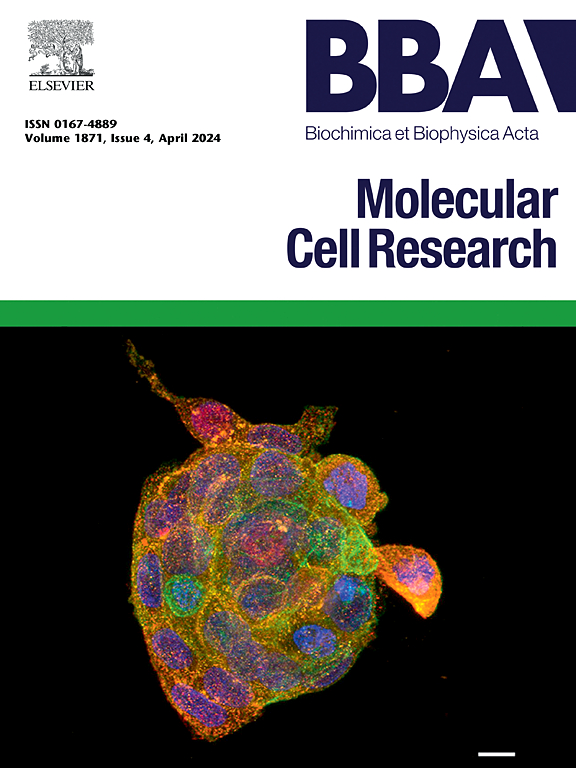靶向TRPML3抑制三阴性乳腺癌的增殖和侵袭,并通过破坏溶酶体酸化和线粒体功能增强阿霉素敏感性。
IF 3.7
2区 生物学
Q1 BIOCHEMISTRY & MOLECULAR BIOLOGY
Biochimica et biophysica acta. Molecular cell research
Pub Date : 2025-05-08
DOI:10.1016/j.bbamcr.2025.119979
引用次数: 0
摘要
TNBC仍然是最具侵袭性和治疗抗性的乳腺癌类型,有效的靶向治疗尚未开发出来。在这里,我们确定TRPML3 (ML3)作为TNBC的潜在治疗靶点。我们的数据显示,与非致瘤性对照细胞相比,ML3在TNBC细胞中显著上调。ML3敲低(KD)通过诱导细胞周期阻滞和caspase依赖性凋亡影响TNBC细胞增殖。ml3kd还能抑制TNBC细胞的迁移和侵袭。从机制上讲,ML3 KD减少溶酶体数量,增强溶酶体酸化,从而激活mTORC1,从而抑制自噬的起始和通量。这种破坏会对线粒体功能产生负面影响,如ATP生成减少、ROS和NO生成增加以及线粒体断裂。重要的是,ml3kd增强了TNBC细胞对阿霉素和紫杉醇的敏感性。这一发现表明,靶向ML3可破坏溶酶体和线粒体的稳态并增强化疗敏感性,表明ML3可能是TNBC中增强化疗敏感性的潜在治疗易感性。本文章由计算机程序翻译,如有差异,请以英文原文为准。
Targeting TRPML3 inhibits proliferation and invasion, and enhances doxorubicin sensitivity by disrupting lysosomal acidification and mitochondrial function in triple-negative breast cancer
TNBC remains the most aggressive and therapy-resistant type of breast cancer, for which efficient targeted therapies have not been developed yet. Here, we identified TRPML3 (ML3) as a potential therapeutic target in TNBC. Our data showed that ML3 is significantly upregulated in TNBC cells compared with nontumorigenic control cells. ML3 knockdown (KD) impairs TNBC cell proliferation by inducing cell cycle arrest and caspase-dependent apoptosis. ML3 KD also inhibits TNBC cell migration and invasion. Mechanistically, ML3 KD reduces lysosomal number and enhances lysosomal acidification, which in turn activates mTORC1, thereby inhibiting autophagy initiation and flux. This disruption negatively impacts mitochondrial function, as evidenced by reduced ATP production, increased ROS and NO production, and mitochondrial fragmentation. Importantly, ML3 KD enhances TNBC cell sensitivity to doxorubicin and paclitaxel. The finding suggests that targeting ML3 disrupts lysosomal and mitochondrial homeostasis and enhance chemosensitivity, presenting ML3 as a potential therapeutic vulnerability in TNBC enhancing chemosensitivity.
求助全文
通过发布文献求助,成功后即可免费获取论文全文。
去求助
来源期刊
CiteScore
10.00
自引率
2.00%
发文量
151
审稿时长
44 days
期刊介绍:
BBA Molecular Cell Research focuses on understanding the mechanisms of cellular processes at the molecular level. These include aspects of cellular signaling, signal transduction, cell cycle, apoptosis, intracellular trafficking, secretory and endocytic pathways, biogenesis of cell organelles, cytoskeletal structures, cellular interactions, cell/tissue differentiation and cellular enzymology. Also included are studies at the interface between Cell Biology and Biophysics which apply for example novel imaging methods for characterizing cellular processes.

 求助内容:
求助内容: 应助结果提醒方式:
应助结果提醒方式:


